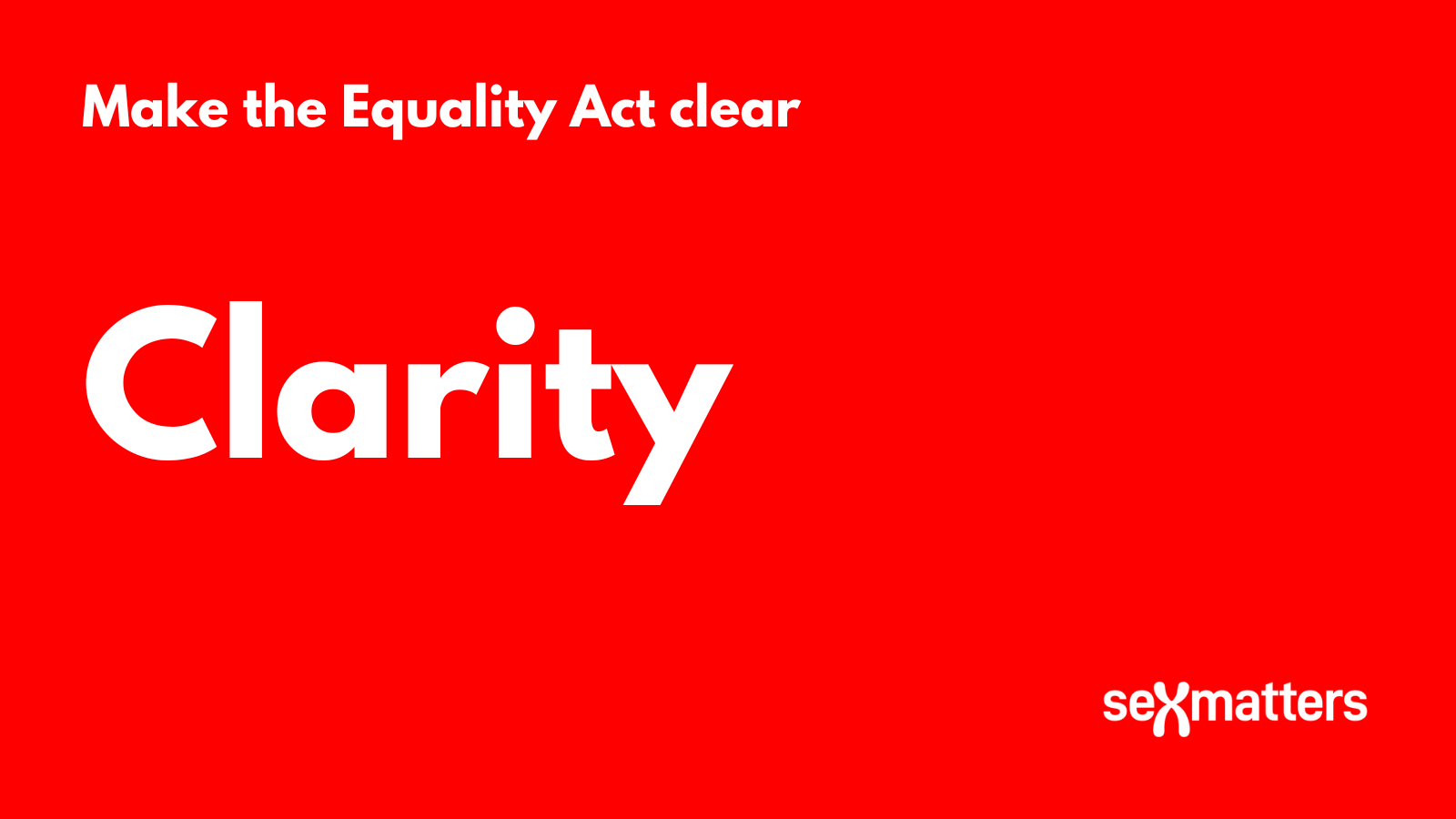Why sex must mean sex across the Equality Act

This is the third in a series of blog posts in the run up to the debate on 12th June about clarifying the Equality Act.
Many people who have written to their MPs about the proposal have had a response that says something like this:
“The current guidance from the Equality and Human Rights Commission (EHRC) on existing legislation says that it is entirely acceptable for providers of single-sex services to take account of the biological sex of their service users. Where it is a proportionate means of achieving a legitimate aim, the Equality Act 2010 is clear that service providers can exclude, modify or limit access for transgender people, even where they have a Gender Recognition Certificate (GRC).”
This is a reference to Schedule 3 Part 7 of the Equality Act (the single-sex services exception). If you have had this reply from your MP, you might want to write back to them and send them this blog post.
The Equality and Human Rights commission has written to the Minister for Women and Equalities and said that in practice service providers have found this interpretation of the law hard to apply. This is not surprising, as its current guidance suggests that anyone providing a service separately for women and men has to think in legalistic terms about whether it is a proportionate means to a legitimate aim to exclude males with the protected characteristic of gender reassignment from the women, rather than having a clear policy that women means female-only. (More recent guidance from the EHRC says that they can have a clear policy, but suggests this is only after surveying users.)
The letter from the EHRC recognises that if the protected characteristic of “sex” is defined to mean biological sex, this would create rationalisations, simplifications, clarity and reductions in risk not just for single-sex service providers but across several areas of the act.
And provisions related to sex discrimination and single-sex situations run through the Equality Act. For the law to work it needs to be clear what this means. This does not just relate to Schedule 3 Part 7; it also relates to the meaning of sex in:
- Sex discrimination and harassment. Is a “transman” with a GRC covered by sex discrimination related to being female in the same way as one without a certificate? (Both can get pregnant and be mothers or face harassment related to their sex.)
- Equal pay. If a male colleague transitions and gets a GRC, is a female colleague who is paid less for the same job unable to bring an equal-pay claim using her male colleague (who is now officially female) as a comparator?
- Sport (Section 195). Separate sporting competitions can be organised for men and women where one sex is generally at a disadvantage in comparison with the other in terms of strength, speed or physique.
- Occupational requirement (Schedule 9). Employers can restrict particular jobs if they can show that they need someone to have a protected characteristic, such as a women’s refuge worker or a bra fitter needing to be female.
- Communal accommodation (Schedule 23). Dormitories, halls of residence and other shared accommodation can be provided for each sex separately for reasons of privacy.
- Charities (Section 193). Charities are allowed to be set up only for women and girls or only for men and boys.
- Associations (Schedule 16). Associations and clubs are allowed to be established for people based on a protected characteristic: a women writers’ association or a group for transgender people.
- Single-sex schools (Schedule 11). Schools are allowed to admit pupils of only one sex.
- Single-sex colleges (Schedule 12). Colleges are allowed to admit students of only one sex.
- Political parties (Part 7). Political parties may make arrangements to address the under-representation of people with particular protected characteristics – this can include single-sex shortlists for election candidates.
- Public-sector duty (Section 149) makes it a legal obligation for local authorities, NHS trusts and other public bodies to assess how their policies impact on people with protected characteristics, including women and girls.
- Positive action (Section 158-158). Employers and service providers are able to take action to overcome the disadvantage or under-representation of people who share particular protected characteristics.
- Opposite sex and same sex. The Equality Act uses the concepts of opposite sex and same sex to define sexual orientation and protect people from discrimination because of it; to recognise that many people feel more comfortable only with people of the same sex when undressing; and to allow religious organisations to operate according to their conscience (including choosing not to solemnise same-sex marriages).
All the different parts of the act need to work together without confusion or difficulty.
For example, a sports organisation might run women’s and girls’ teams (competition), organise training sessions (service), have changing rooms and showers (service), create an award or bursary scheme to get women into the sport (positive action), employ a community outreach worker who needs to be a woman (occupational requirement), take teams on tour involving dormitories or shared bedrooms (communal accommodation), have an association for women in the sport (association) and apply for charitable status for it (charity). It will also need to monitor how it is doing on diversity and equality more broadly by collecting data (public-sector equality duty).
It shouldn’t be difficult or complex to do these things.
The Equality Act was intended to be user-friendly and clear. You shouldn’t need a lawyer or a degree in gender studies to understand it. The sports organisation above shouldn’t need to fear legal challenges or have to justify that it is lawful to be clear that “women” means female, in relation to all these different sections of the Equality Act separately.
A simple workable law is only possible if the protected characteristic of “sex” means sex across the whole of the Act.
